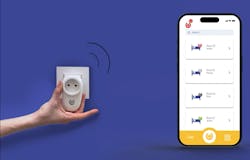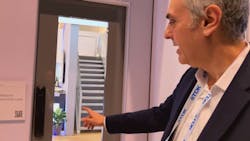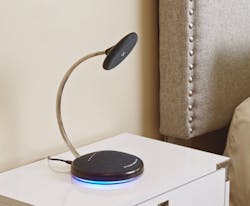Presence Detection Gains Momentum on CES Show Floor
This article originally appeared as part of the industry’s ONLY full CES show coverage in the February 2024 issue of Security Business magazine. Don’t forget to mention Security Business magazine on LinkedIn and @SecBusinessMag on Twitter if you share it.
LAS VEGAS – In the area of health and safety monitoring, CES 2024 has a wide variety of tech on display. Most relevant to the security and elderly monitoring industry was the propagation of presence detection devices. Primarily designed for fall detection and active care situations, these devices can rely on a variety of technologies, such as radar, Wi-Fi, LiDAR, ultra-wideband, and even ultrasonic to achieve a similar outcome – much of it, of course, with the help of artificial intelligence.
Another unifying factor in this area of technology is a move away from analytics and other video-based technologies. Most of these solutions tout privacy as one of the factors in its favor, as many stated flatly that seniors are often very uncomfortable with the idea of in-home or in-room video surveillance.
New Alarm.com Radar-Based Solution
Boston-based Cherish Health Inc., announced at CES a new partnership with Alarm.com to bring the Cherish Serenity – an AI-powered multi-person, multi-room radar-based presence detection system – to Alarm.com service providers.
“Cherish Serenity is a device that uses radar to detect body position of multiple people, across multiple rooms, within an entire home,” explains Sumit Nagpal, the founder and CEO of Cherish. “It is designed to keep people who are either aging or living with health challenges safe. When you drop it in a corner, plug it in, and forget about it, it immediately figures out where all the solid objects are – where the walls are – and it tracks people beyond them. For up to two people, it continuously detects when they are sitting, standing, walking, lying down, or falling. It does that with AI – at the edge in the device itself.”
Because detection is achieved at the edge, no footage actually leaves the device, preserving privacy; in fact, there is no video camera associated with the device at all. The radar data is converted into a 13-point skeleton – limbs, torso and head – and the software learns and understands the positions of that skeleton over time.
“We are able to actually track body position very accurately to know whether someone actually intended to sit down on the ground or whether they had a fall,” Nagpal adds. “lt can detect whether you grabbed onto a table during a fall and hit the ground in a way that an accelerometer would not have picked up. We use machine learning and AI to determine, for example, if someone is just lying on the ground on purpose vs. someone who falls.”
Nagpal says they are just scratching the surface of the radar-and-AI technology’s capabilities. “We have already proven in our lab that we can detect heart rate and respiration from 40 feet away through two walls with no wearable,” he says. “We are able to measure gait or count someone’s steps, or time to rise. All of these biometrics provide unprecedented levels of information about a person’s daily activity without them having to think about it.”
Nagpal recommends that alarm.com dealers leverage this technology to help them break into the wellness and elderly care markets, including assisted living and healthcare facilities.
With a look more like a standalone tabletop speaker vs. a PIR or video surveillance device, the sensor also features two-way communication. When a fall is detected, it can notify caregivers or a response center for timely help. “This device goes beyond being a sensor – it protects with the sensing but it also connects,” Nagpal says.
The device will integrate with Alarm.com’s Personal Safety + Awareness platform and should be available to dealers soon.
Wi-Fi Meets AI: Zoe Care
France-based Zoe Care touted a Wi-Fi based fall detection solution, Zoe Fall. “Zoe Care has pioneered a distinctive sensing technology that scans and analyzes prevailing electromagnetic radio waves. Using a patented AI algorithm, it can accurately identify human motion.”
The company claims that unlike radar systems, it does not rely on a direct line of sight between an emitter and the human body; and unlike most motion recognition algorithms, it operates independently without the need for cloud computing. All computations are processed locally on a lightweight chip.
Zoe Fall can accurately identify both abrupt and gradual falls, eliminating the need for sensors in every room, all without capturing any images or audio. The technology also recognizes various movements like walking, standing up, lying down, breathing, eating, drinking, and others. “These detailed physiological insights are crucial for monitoring the health of chronic disease patients or elderly individuals at risk of losing autonomy,” the company says.
Will Sonar Overtake Radar?
At CES, TDK Corporation showcased a variety of use-cases for its ultrasonic Time-of-Flight (ToF) sensors. These sensors use a tiny ultrasonic transducer chip to send out a pulse of ultrasound and then listen for echoes returning from targets in the sensor’s field-of-view. By calculating the ToF, the sensor can determine the location of an object relative to a device and trigger a programmed behavior.
“Ultrasound technology is just what it sounds like – we push out beams of sound,” explains David Almoslino, TDK’s VP of Corporate Communications. “It’s harmonic, and it goes and bounces against something and comes back, and then you read it. Now, because we can measure the speed of sound, we know that the bounce effect, and how long that took, we can correlate it to a distance.”
TDK then demoed the sensor embedded in a Phillips smart lock. Using the ultrasonic sensor, when a target approaches and stops in front of the lock, the equipped sensor module will quickly calculate the waves reflected from the target. If it detects a human movement, it wakes up the lock – helping to preserve the battery life of the lock using smart detection.
“You can set that ultrasonic to a certain distance so it is not triggered when someone walks by who is too far away,” Almoslino adds.
TDK is not in the smart lock business; however, they are applying a common technology – ultrasonic detection – to other manufacturers who can adapt it to a specific use-case for distance and detection, such as in the Phillips smart lock it displayed.
In another example, TDK announced in 2022 the successful integration of the ultrasonic ToF sensors into the Kaadas K9-F 3D Face Push-Pull Wi-Fi smart door lock, enabling its face recognition functionality to automatically awaken and unlock for recognized users when they approach.
“There are other possible security applications for ultrasonic detection, such as presence detection,” explains Massimo Mascotto, TDK’s Director of Product Marketing, adding that the use-case is similar to micro-motion radar, but using sonic. “There are a lot of weaknesses in PIR sensors, so we already have an application for our ultrasonic ToF sensor in a security system to detect people. Another example would be in a smoke detector to check if someone is still inside the room when there is smoke.”
Mascotto adds that the major difference between radar and sonar is power consumption. “We are in the range of 1,000 times less power needed,” he says. “If something is battery-powered, ultrasonic is the right technology.
Another difference is a common ultrasonic sensor is the size of a quarter; the TDK module is much smaller, so it can be embedded in devices more easily. “Also, the sensor works with any material – it could be metal or plastic,” Mascotto says.
Other Presence Detection Highlights
TrueSense, an Italian company I saw among the startups at Eureka Park, is developing ultra-wideband for two applications: ranging (measuring the distance and angle between two objects), and UWB radar to detect micro-motion, such as breathing, and movement such as fall detection. Check them out in Part One of my Eureka Park floor walk video (right) with expert consultant Pierre Bourgeix.
In the same video, we checked in for the second year in a row on Switzerland-based Algorized, which is a UWB sensing software integrated into several chips. While the company showcased in-building UWB in 2023, this year, they highlighted an automotive application, using its software within Qorvo’s Ultra-Wideband Radar chipset to detect presence in vehicles, such as children left in the back seat.
Xandar Kardian’s XK-FD (Fall Detection Sensor) is a new product that is propelled by the same radar technology as the company’s flagship XK300 sensor, an award-winning, FDA 510(k) cleared class II medical device. Debuting in early 2024, XK-FD is designed specifically for deployment in bathrooms. The product leverages Xandar Kardian’s presence detection and vital sign monitoring to successfully detect fall events in medical and household restrooms.
Finally, in Part Two of the Eureka Park exploration with Pierre Bourgeix, we met with Swiss company Sedimentium AG, whose Safe-Living solution also uses radar packaged in a tabletop device that looks similar to a smoke detector. It detects motion and reports it on an app for family members and caregivers.
Paul Rothman is Editor-in-Chief of Security Business magazine. Email him your comments and questions at [email protected]. Access the current issue, full archives, and apply for a free subscription at www.securitybusinessmag.com.
About the Author
Paul Rothman
Editor-in-Chief/Security Business
Paul Rothman is Editor-in-Chief of Security Business magazine. Email him your comments and questions at [email protected]. Access the current issue, full archives and apply for a free subscription at www.securitybusinessmag.com.





